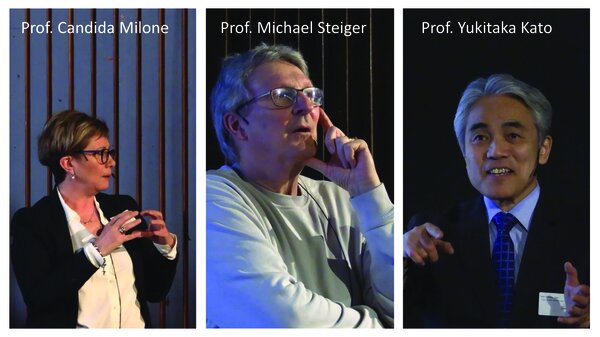How to serve the need for storage of heat
‘Today, we want to provide you with a flavor of recent thermochemical developments at different labs.’ With these words, EIRES researcher Henk Huinink welcomed some 80 participants to the symposium Thermochemical Energy Storage on 8 March 2023 at TU/e.
‘The built environment is responsible for 25 percent of the total energy consumption. Some 70 to 80 percent of this is accounted for by thermal energy, used for heating water and rooms,’ Huinink set the stage. Thermochemical energy storage (TCES) is a promising technology for compact long term heat storage. Reversible physical-chemical reactions between solids and gasses can be used to store and release heat. By selecting a specific reaction type, one can tune in on the temperature levels required by the application. The unique feature of TCES is that the energy is stored loss free as long as the solid and gas are separated. This makes the concept ideal for long term storage. There are several scientific challenges for implementing the technology in real applications, which range from material properties, device complexity to system integration. During the symposium, international experts in the field covered both materials development and system integration aspects.
Challenges of using salt
Michael Steiger from Hamburg University first took the stage to discuss the possibilities of using salt hydrates for heat storage. Besides some huge advantages, salt hydrates also come with issues, he explained. ‘They tend to come with inappropriate thermodynamics, inappropriate kinetics, unwanted side reactions, lack of cycle stability and limited availability of materials. We try to solve these issues by using mixtures or adding additives of promising salt hydrates.’ His group studies the interaction between the salt and the additives to get a grip on the reaction speed and efficiency. During his talk, he presented carnallite (hydrated potassium magnesium chloride) as a new, promising material that ensures rapid rehydration at low vapor pressures, easily dehydrates, has a reasonably high storage density and does not suffer from liquefaction or hydrolysis issues.
Enhancing materials
The next speaker, Candida Milone from the University of Messina, delved into the chemistry. In her talk, she highlighted some synthetic approaches to enhance materials for thermochemical energy storage. Her group mainly focusses on low (30-150 degrees Celsius) to middle (150-400 degrees Celsius) temperature ranges. She also presented some recent experiments to improve the heat transfer properties of the pair Mg(OH)2/MgO. For example, the group explored the merits of confining the inorganic salt in a foam structure with a good permeability for water.
Role of heat storage in the energy mix
The final speaker of the day was Yukitaka Kato from the Tokyo Institute of Technology. He started by explaining that Japan imports a large part of its energy from overseas. At the moment, some 85 percent of the energy demand is met by fossil fuels. Some 75 percent of this total energy demand is heat. ‘To drastically reduce our CO2 emissions, what we need are zero carbon energy solutions, a well thought through energy storage mix, and solutions for carbon recycling,’ he stated. Since thermochemical energy storage has the potential to store heat with a relatively high energy density for longer periods, and can also upgrade the heat output temperature by its chemical heat pump ability, Kato foresaw a promising future for these types of materials in Japan’s energy mix of the future.
DOWNLOADS
Program
Full program, speakers info and more
Recordings
- Re-watch symposium Thermochemical Energy Storage | 08 March 2023
- Click on 'meer tonen' for an overview of all speakers/blocks
Available slides
Word of welcome
by Henk Huinink | Eindhoven University of Technology
Using salt mixtures / double salts in thermochemical storage
by Michael Steiger | Hamburg University
Synthetic approaches to enhance materials for thermochemical energy storage
by Candida Milone | University of Messina
Thermochemical energy storage in energy storage mixed systems
by Yukitaka Kato | Tokyo Institute of Technology

Questions?
Any comments or questions? Please let us know
